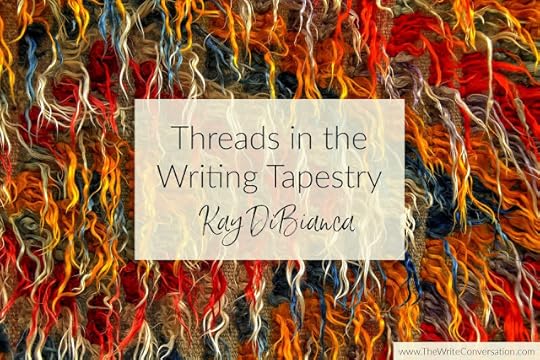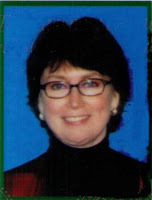Threads in the Writing Tapestry

by Kay DiBianca @KDiBianca
My husband and I had the good fortune to visit the Vatican Galleries in Rome some years ago. One memory I have was standing in front of several enormous tapestries that recorded events from the Gospels. I was astounded at the workmanship that told a story by weaving different color threads onto a background. I wondered if the weavers had used any special thread, maybe a gold or silver one, to highlight each one of his works.
It’s not much of a leap to compare the creation of a colorful, intricate tapestry with a novel. Both tell a story, but each uses a different set of raw materials. I began to think of my own novels as stories woven with individual words that produce a complex whole.
When I began my Watch series of cozy mysteries, I had not intended to weave certain threads through each of the novels. The main characters, of course, are the foundation around which all the rest of the stories revolve. But I found several other threads made their way through each of the books without my explicitly planning it that way. Here are four of them.
1. I’m a runner, so it’s not surprising that there are running scenes in each book. The first book begins with one of the main characters, Kathryn, training for a marathon. The second novel has the same character injured during a half-marathon, and the third story includes references to running.
2. The other main character in my books, Cece, is an actress, and she loves disguises. In each one of the books, Cece goes into disguise at least once, sometimes with surprising consequences.
3. Each book also contains a chapter describing a Shabbat dinner. As the diners enter into the Sabbath during the meal, something illuminating always happens.
I did not intentionally add those three elements to my series. They just happened to fit well into each story. However, a fourth thread is one that I determined I would add to every book I write:
4. My husband, Frank, coined a word when he invented and patented a medical imaging device which he named the Kinestatic Charge Detector. Although you won’t find the word “kinestatic” in the dictionary, you will always find it used at least once in each of my books. “Kinestatic” means something that is moving (kinetic) in one frame of reference, but still (static) in another. A good example is a runner on a treadmill. The runner is moving with regard to the treadmill, but still in regard to the room. The word can be used to describe so much in life. One example is running around all day doing errands, but feeling like you haven’t accomplished anything.
So these are the threads that keep popping up in my tapestry-novels. I hope they serve as tiny reminders to reassure readers they’re in familiar and comfortable territory.
Do you weave threads through your stories to add a sense of familiarity for your readers?
Kay DiBianca is a former software developer and IT manager who retired to become an award-winning author of cozy mysteries. She loves to create literary puzzles for her readers to solve, and her characters come to life as they struggle to solve murders and create relationships amidst the ongoing themes of faith and family.
TWEETABLEThreads in the Writing Tapestry, insight from author @KDiBianca on @EdieMelson (Click to Tweet)
 Kay is a member of the American Christian Fiction Writers, Sisters in Crime, and the Collierville Christian Writers Group. She is also a regular contributor to the Kill Zone Blog. An avid runner, she can often be found at a nearby track, on the treadmill, or at a large park near her home. Kay and her husband, Frank, live, run, and write in Memphis, Tennessee. You can connect with Kay through her website at https://kaydibianca.com.
Kay is a member of the American Christian Fiction Writers, Sisters in Crime, and the Collierville Christian Writers Group. She is also a regular contributor to the Kill Zone Blog. An avid runner, she can often be found at a nearby track, on the treadmill, or at a large park near her home. Kay and her husband, Frank, live, run, and write in Memphis, Tennessee. You can connect with Kay through her website at https://kaydibianca.com.
Published on June 28, 2022 22:00
No comments have been added yet.



